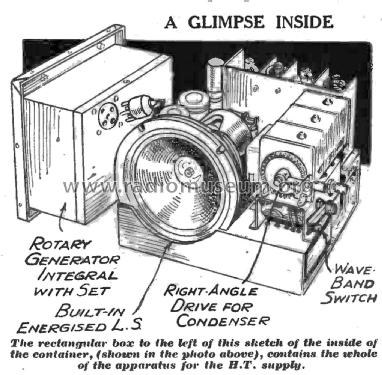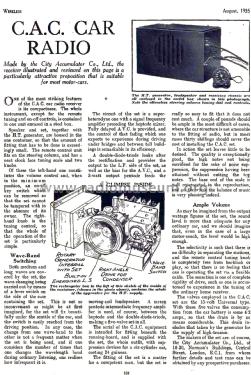- Pays
- Royaume Uni
- Fabricant / Marque
- CAC (C.A.C.) City Accumulator Co. (Radio Ltd. Valve/Cabinets); London
- Année
- 1935
- Catégorie
- Radio - ou tuner d'après la guerre 1939-45
- Radiomuseum.org ID
- 346881
-
- Brand: CAC
- No. de tubes
- 5
- Lampes / Tubes
- Principe général
- Super hétérodyne avec étage HF
- Gammes d'ondes
- PO et GO
- Tension / type courant
- Accumulateur (par exemple pour autoradios ou radio) / 12 Volt
- Haut-parleur
- HP dynamique à aimant permanent + bobine mobile
- Puissance de sortie
- 3 W (sans distorsion)
- Matière
- Boitier métallique
- De Radiomuseum.org
- Modèle: C.A.C. Car Radio - CAC C.A.C. City Accumulator Co
- Forme
- Chassis (pour intégration dans meuble)
- Remarques
-
C.A.C. Car Radio
One of the most striking features of the car radio receiver is its compactness. The whole instrument, except for the remote tuning and on-off controls, is contained in one unit encased in a steel box. The speaker and set, together with the H.T. generator, are housed in one container so that the amount of fitting that has to be done is exceedingly small.
The remote-control unit fits on the steering column and has a neat clock-face tuning scale and two knobs. Of these, the left-hand one constitutes the volume control and, when in the minimum position, an on-off key switch that can be removed so that the set cannot be tampered with in the absence of its owner. The righthand knob is the tuning control, so that the whole operation of the set is particularly simple.
Wave-Band Switching
Both medium and long waves are covered by the set, the wave changing being carried out by means of a lever switch on the side of the case containing the set. This is not so inconvenient as might be at first imagined, for the set will fix beautifully under the scuttle of the car, and the switch is easily reached from the driving position. In any case, the change from one waveband to the other is not a frequent matter when the set is being used, and if one considers the number of times that one changes the wavelength band during ordinary listening, one realises how infrequent it is.
The circuit of the set is a superheterodyne one with a signal frequency amplifier preceding the heptode mixer. Fully delayed AVC is provided, and the control of that fading which one expects to experience during driving under bridges and between tall buildings is remarkable in its efficiency.
A double-diode triode looks after the rectification and provides the output to the L.F. side of the set, as well as the bias for the AVC, and a 3-watt output pentode feeds the moving coil loudspeaker. A screen pentode intermediate frequency amplifier is used, of course, between the heptode and the double-diode-triode, making a five-valve set in all. The aerial of the C.A.C. equipment is intended for fitting beneath the running board and is supplied with the set, the whole outfit, with suppression devices for a six-cylinder car, costing 24 guineas.
The valves employed in the C.A.C. set are the 13-volt Universal type. With these five valves the consumption from the car battery is some 4.2amps., so that the drain is by no means considerable. This drain includes that taken by the generator for the supply of high-tension.
- Prix de mise sur le marché
- 24.00 GNS
- Littérature
- -- Original prospect or advert (Wireless & TV Review Aug 1935, Page 104.)
- Auteur
- Modèle crée par Gary Cowans. Voir les propositions de modification pour les contributeurs supplémentaires.
- D'autres Modèles
-
Vous pourrez trouver sous ce lien 10 modèles d'appareils, 9 avec des images et 1 avec des schémas.
Tous les appareils de CAC (C.A.C.) City Accumulator Co. (Radio Ltd. Valve/Cabinets); London

